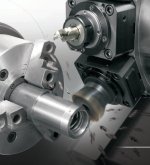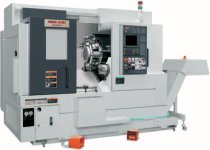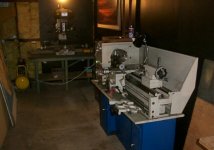You guys!!I suspect our OP did not already win the Lotto!
Yeah,I really am partial to the Monarch EE,and yeah,a Hardinge is great to thread with and has a good tailstock etc...
Those are accurate,rigid,fine machines.I like Colchester and Cincinatti,too
I have worked on all those.
A 1941 South Bend Navy Signal Corp 10 x 36 ,if it is in good shape,is a dandy gunsmith lathe.
If the variable drive hasn't gone wobbly,a 10x 36 Clausing is quite nice
I ran a Harrison 10 in gearhead lathe for several years,I would like to find myself one.
An old Logan might be OK,too
All of these(I would hope) can be found in the $1500 to $3000 range,
I paid $400 for the South Bend ,a buddy and I overhauled it,and it has been gunsmithing for 30 years,and still serves.
Does it look clean and well kept?Does it have a lot of backlash? That can often be tuned out if it has a split nut,but it is still wear.Shake/wiggle the carriage and compound.Rattling like an old GI 1911 is not good here.Taking up gibs will tune it some,but it is still wear.Bonus if it has a leadscrew and a seperate drive shaft for feeds.The threading halfnuts are subject to wear and damage,check the threading engagement lever,how it feels.The usual issue is a wear pattern of semi-engaged,which makes threading frustrating.FRankly,on an old beater lathe,threading up to a shoulder,as in a bbl,I might put the lathe in neutral,turn off the breaker,engage the thread lever and leave it there through the whole job,and turn the chuck by hand.Very slow,and a pain in the...but,no wrecks.
Look at the ways in general.Dings,dents? Tools and whacking on the ways is not good.There will be some extra wear close to the chuck,how much?Score marks means hard chips and grit were likely blown by airhose up under the wipers(use a brush).The tailstock is important,look inside the taper for chip dents and scoring from spinning a chuck.
The tailstock ways,look at them for wear.Drilling and reaming are funny when the tailstock is lower than the headstock.
Look at the headstock spindle nose for marks left by folks not cleaning the tapers.(allways make sure all precision surfaces are immaculate before assembly,spindle tapers,chuck jaws,etc.
Unfortunately,usually you can't run a lathe that is on a pallet to go out the door.You can learn a lot with an indicator and a piece of ground round stock.
For a mill,I'd likely hold out for a Bridgeport.It is an arguable point about the cost effectiveness of the clones,but I like a Bridgeport.
Tilting the head,and being able to swing the head over and hang work over the side of the table is real useful sometimes.
The 42 in table is usefull with stockwork and octagon cutting.
Yeah,I really am partial to the Monarch EE,and yeah,a Hardinge is great to thread with and has a good tailstock etc...
Those are accurate,rigid,fine machines.I like Colchester and Cincinatti,too
I have worked on all those.
A 1941 South Bend Navy Signal Corp 10 x 36 ,if it is in good shape,is a dandy gunsmith lathe.
If the variable drive hasn't gone wobbly,a 10x 36 Clausing is quite nice
I ran a Harrison 10 in gearhead lathe for several years,I would like to find myself one.
An old Logan might be OK,too
All of these(I would hope) can be found in the $1500 to $3000 range,
I paid $400 for the South Bend ,a buddy and I overhauled it,and it has been gunsmithing for 30 years,and still serves.
Does it look clean and well kept?Does it have a lot of backlash? That can often be tuned out if it has a split nut,but it is still wear.Shake/wiggle the carriage and compound.Rattling like an old GI 1911 is not good here.Taking up gibs will tune it some,but it is still wear.Bonus if it has a leadscrew and a seperate drive shaft for feeds.The threading halfnuts are subject to wear and damage,check the threading engagement lever,how it feels.The usual issue is a wear pattern of semi-engaged,which makes threading frustrating.FRankly,on an old beater lathe,threading up to a shoulder,as in a bbl,I might put the lathe in neutral,turn off the breaker,engage the thread lever and leave it there through the whole job,and turn the chuck by hand.Very slow,and a pain in the...but,no wrecks.
Look at the ways in general.Dings,dents? Tools and whacking on the ways is not good.There will be some extra wear close to the chuck,how much?Score marks means hard chips and grit were likely blown by airhose up under the wipers(use a brush).The tailstock is important,look inside the taper for chip dents and scoring from spinning a chuck.
The tailstock ways,look at them for wear.Drilling and reaming are funny when the tailstock is lower than the headstock.
Look at the headstock spindle nose for marks left by folks not cleaning the tapers.(allways make sure all precision surfaces are immaculate before assembly,spindle tapers,chuck jaws,etc.
Unfortunately,usually you can't run a lathe that is on a pallet to go out the door.You can learn a lot with an indicator and a piece of ground round stock.
For a mill,I'd likely hold out for a Bridgeport.It is an arguable point about the cost effectiveness of the clones,but I like a Bridgeport.
Tilting the head,and being able to swing the head over and hang work over the side of the table is real useful sometimes.
The 42 in table is usefull with stockwork and octagon cutting.
Last edited:





